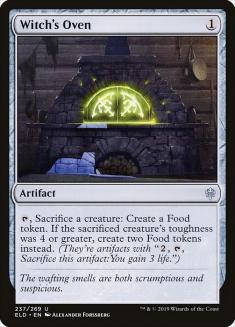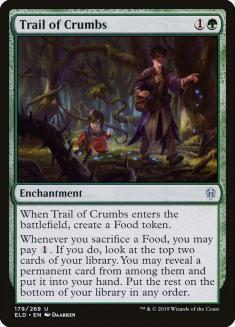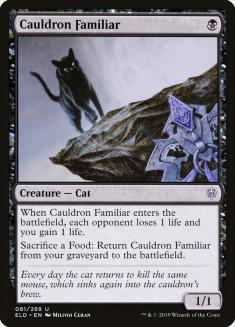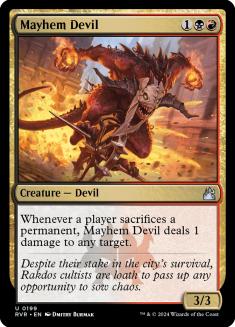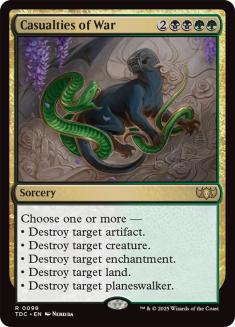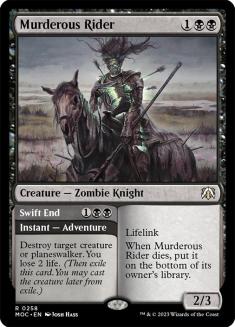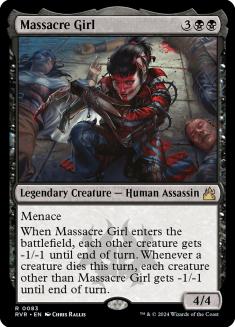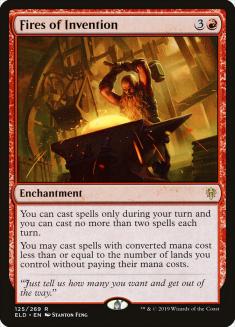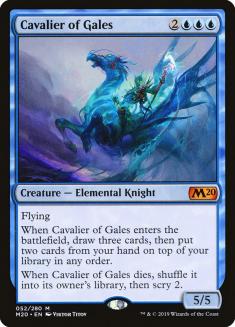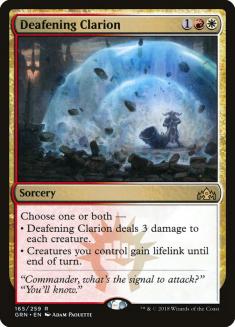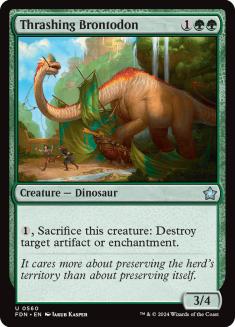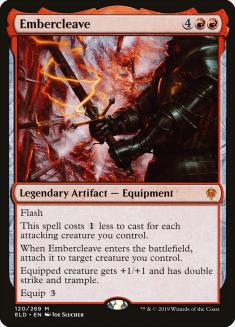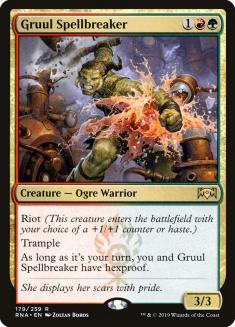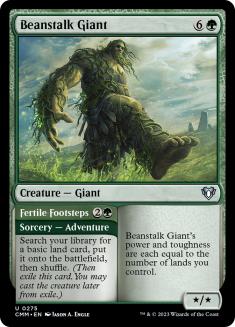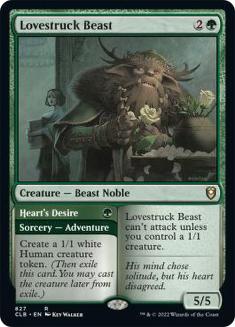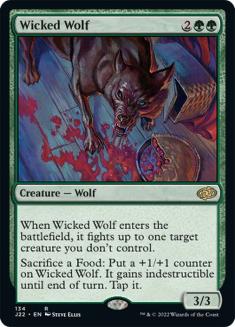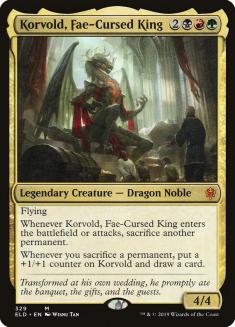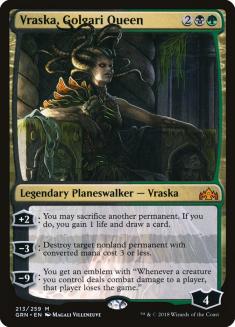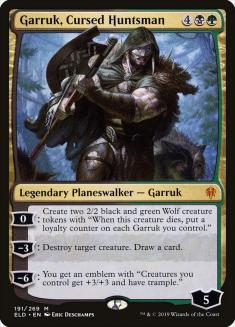It’s a good time to be cooking.
Last weekend, Piotr Glogowski took down Mythic Championship VII with his take on Jund Sacrifice, going completely undefeated throughout the event:
Creatures (23)
- 2 Thrashing Brontodon
- 4 Mayhem Devil
- 2 Massacre Girl
- 4 Gilded Goose
- 2 Korvold, Fae-Cursed King
- 3 Beanstalk Giant
- 2 Murderous Rider
- 4 Cauldron Familiar
Lands (19)
Spells (18)

What is it that sets this deck apart from other Sacrifice decks in the format? It’s that it’s a hybrid deck.
Frequently, we’ll use archetype-defining words in the vein of “control” and “aggro” to give a rough idea of the axis that a deck is trying to operate on. For example, a control-combo deck is going to have a controlling role before ultimately winning the game with some sort of combo. The most recent version of this that we’ve seen in Standard is Temur Reclamation:
Creatures (5)
Lands (22)
Spells (33)
- 2 Mountain
- 1 Island
- 3 Shock
- 4 Opt
- 4 Chemister's Insight
- 4 Expansion
- 4 Growth Spiral
- 4 Wilderness Reclamation
- 2 Flame Sweep
- 2 Aether Gust
- 3 Mystical Dispute
Sideboard

Defining something like Jund Sacrifice is traditionally going to fall under the midrange umbrella. It does, however, fly in the face of how a good chunk of midrange decks operate. That’s to say that rather than trying to beat other decks on the back of superior average card quality, Jund Sacrifice leans harder into its synergies in order to go outclass other strategies, making it a synergy-midrange deck.
Why is this distinction important? It’s all about framing.
When piloting decks that are multifaceted, each matchup is going to demand leaning into one role over the other, for the sake of prioritizing plans. Looking back to Temur Reclamation, for example, some matchups are going to be difficult for the deck to interact with, meaning that it needs to lean as hard as possible into going off with Wilderness Reclamation, rather than drawing the game out with its removal and card draw. Jund Sacrifice has similar decision trees.
Role Assessment
When playing with Jund Sacrifice, there are two kinds of cards:
Synergy cards like Trail of Crumbs, Mayhem Devil, and so on will be better in the high-resource games that this deck is typically known for. These are the matchups where Jund Sacrifice is operating under the assumption that if both players are left to their own devices, Jund will be able to go over the top of what the opponent is doing.
The incentive to leaning into this strategy is clear when watching replays from the event, where Glogowski is able to establish battlefield synergies that are more powerful than the cards from Simic Flash:
Creatures (15)
Planeswalkers (4)
Lands (12)
Spells (29)

On average, the cards in Simic Flash are more powerful than the ones from Jund Sacrifice, but that falls by the wayside when Jund starts combining multiple pieces.
Conversely, there’s the interactive and midrange-y side of things. The interactive pieces of the deck are more powerful cards because they have to be. Anything more subtle is going to do so little that it necessitates diluting the synergy deck. Cards like Casualties of War are necessary for the matchups that have the ability to go over the top of what Jund Sacrifice is doing (think Jeskai Fires).
Creatures (15)
- 4 Sphinx of Foresight
- 4 Cavalier of Flame
- 3 Cavalier of Gales
- 2 Kenrith, the Returned King
- 2 Bonecrusher Giant
Planeswalkers (4)
Lands (22)
Spells (19)

Regardless of how many cards Trail of Crumbs generates, or how good Mayhem Devil is at locking up the battlefield, a Deafening Clarion into Cavalier of Flame can just end the game. Keeping those kinds of turn cycles out of reach is the purpose of cards like Casualties of War.
With a deck as complex as Jund Sacrifice, every turn is going to have so many decision points that it isn’t as realistic to write a sort of “how-to” guide in the style of my previous article on Rakdos Sacrifice. With Jund Sacrifice, it’s more productive to focus on learning the macro-approach to matchups and let that understanding inform the in-game choices that you make.
As I mentioned previously, Jeskai Fires is an example of a deck that demands interaction. When sideboarding, you’ll want to get away from some of the synergy cards that generate more incidental value.
Mayhem Devil, for example, has almost no relevant text against Jeskai Fires. In spite of the fact that the card can frequently generate a free Arc Lightning every turn, that isn’t actually relevant text against a deck that wins games with enchantments and value-packed 5/5s.
Instead, having cards that are able to interact with their problem cards is going to be a more realistic avenue to victory. Duress and Thrashing Brontodon aren’t exactly going to contribute to the sweet Trail of Crumbs synergies that the deck is known for, but this is the kind of synergy that needs time in order to do its thing. Cards that stop you from getting punked out of the mid-game are crucial.
Gruul Aggro is a prime example of something that’s operating on an axis that will fall prey to Jund Sacrifice’s synergies. Outside of the stray Embercleave or Skarrgan Hellkite, nothing in the deck is going to amount to very much on its own and will be easily blanked or answered by the Cat Oven combo and Mayhem Devil. This is the kind of matchup where it is correct to lean away from the big flashy cards and lean into pushing synergies and mana efficiency.
Casualties of War just isn’t necessary. By extension, Beanstalk Giant isn’t going to be doing much. Against an aggro deck, ramping up to five mana isn’t as valuable as simply having more cards to contribute to the battlefield during the early stages of the game.
Take for example the remaining green creatures out of the sideboard. They’re great at clogging the battlefield, and Wicked Wolf has the benefit of playing with Trail of Crumbs. Gumming things up will inevitably favor the player who is able to go bigger, and there isn’t anything from the Gruul deck that is going to compete with Korvold, Fae-Cursed King or multiple copies of Trail of Crumbs.
Ultimately, the idea that this is meant to impress is understanding whether your role, as the Jund Sacrifice player, is trying to add complexity to a game, or to reduce it.
Complexity
“Complexity” is a term used to describe how much is going on in a game of Magic. Whenever both players have a low number of total resources, that’s a low-complexity game state. By that same token, both players having seven creatures, no good attacks, and a laundry list of possible actions they can take is a high-complexity game state.
Games with Jund Sacrifice boil down to sussing out your relationship with complexity in the matchup. Identifying this role is a matter of looking at how well the opponent’s cards add to one another, and if they’re doing something that Jund won’t be able to beat.
At the risk of beating a dead horse, the aforementioned Jeskai Fires line of Deafening Clarion into lethal attackers is an example of something that requires reducing complexity in order to avoid having the opponent beat you.
In a majority of the other possible matchups in Standard, Jund’s path to victory lies in increasing the complexity of the game. This is a result of the fact that all of the deck’s cards are expendable, so long as they generate some sort of value before they’re dealt with.
With the London Mulligan in full effect, finding Trail of Crumbs and Korvold isn’t exactly difficult. Couple that with Mayhem’s ability to crowd control, and the deck’s ability to gain value from cards as soon as they hit the battlefield, without relying solely on enters-the-battlefield abilities.
The place where this gets the trickiest is in the mirror match. The absolute most important trap to avoid in the mirror is focusing too hard on trying to interact with what the opponent is doing. As an example, Bryan Gottlieb recently wrote a Jund Sacrifice primer on this very website that includes him humble-bragging about a game in which he easily ground through an irrelevant copy of Casualties of War from the opponent.
This isn’t to say that Casualties of War is always going to be irrelevant, or is the first card to reach for when shaving things for better interaction out of the sideboard. Casualties of War can be just fine. The first cards to reach for are the ones that aren’t going to meaningfully impact the card advantage engines at play here:
In any matchup that demands pushing the complexity of the game to its limits, sideboarding is going to come down to figuring out which cards are the least impactful against what the opponent is doing. There are only so many slots that can be occupied by non-synergy pieces. Maximizing those slots is important.
Murderous Rider is the kind of card that is going to look fine, because it can answer Mayhem Devil and Korvold, but the reality of the situation is that mana efficiency isn’t that important in a matchup that’s slated to go twenty or more turns. Having the most powerful removal spell possible, Casualties of War, is a better direction to push interaction for the matchup.
These kinds of thought processes are the second half of what’s involved in sideboarding with any synergy deck. With a hybrid deck like this one, assessing which role should be emphasized is going to tell you how to play your cards, but the specifics of what cards are important in a matchup will influence the cards you play with.
Take the differences between Golgari Sacrifice and Rakdos Sacrifice. In both matchups, the goal is to increase the complexity of the game and interact with the important pieces of what the opponent is doing. The method of doing so will differ between the two.
Take Massacre Girl and Duress, for example. The two are ultimately interactive pieces that aren’t going to be all-stars in the matchup. The efficacy of each is going to vary based on what cards the opponent has.
Golgari Sacrifice leans more into planeswalkers than Rakdos does. When you add this to Trail of Crumbs and Witch’s Oven, there’s a serious case to be made for a few copies of Duress sliding into the deck in order to preempt these haymakers.
Against Rakdos Sacrifice, Duress isn’t as reliable an answer to cards, because instead of planeswalkers, the deck has Mayhem Devils and Korvolds. Massacre Girl isn’t always going to be attractive, but it is better at answering Mayhem Devil.
With any deck, the process of role assessment-into-card evaluation is going to give a more informed idea of what cards are important during deckbuilding and sideboarding. With a midrange-synergy deck like Jund Sacrifice, this method is more applicable than ever.

